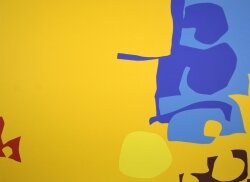Getting into shape: Printmakers color perceptions
“How to Steal like an Artist” is a humorous blog post by Texas-based artist Austin Kleon, full of down-to-earth advice for creative types. (Google it, if you’re not reading this online where there’s a hyperlink). Kleon writes that artists by nature constantly cop others' ideas and methods, adapting them for their own use. Examples of just such beneficent thievery are currently on view in the University of Virginia Art Museum’s exhibition, “New Images, New Techniques: Abstraction in British Screenprints circa 1970.”
The seven artists included in the show not only appropriated silkscreen printing from the realm of industrial and commercial production, but they also snagged ideas from previous abstract artists as well as from each other. Drawn from the Museum’s permanent collection, the works displayed reveal the dynamic interplay of ideas between artists working in close proximity, as they used the same medium to delve into relationships between shape and color on the page.
Particularly well suited for geometric abstraction, screenprinting enables artists to create clean-edged areas of color by placing a stencil on mesh stretched across a frame and then using a squeegee to push ink— usually evenly— through the fabric. Each pigment requires a clean screen, so each successive pass requires precise placement with regard to previously printed areas.
The process also lends itself to exploring variations on a theme, as printmakers often re-use stencils to repeat the same or similar shapes but in different color combinations. In the current show, Patrick Hern’s three prints from his “Small Red January” series offer the same constellation of shapes, reminiscent of Henri Matisse cutouts, with only two shapes changing color: a scalloped vertical near the top, and a nearby horizontal. But the variance in these two elements— from violet and acid green in #1, to acid green and violet in #2, to royal blue and violet in #3— changes the perception of the other colors in the image.
Another artist who plays with color acuity is Robyn Denny, who subtly varies the rectangular forms in his architectural compositions while dramatically changing up the interaction of super-saturated pigments. Going in a different, more minimal direction, Justin Knowles’ pieces in “A Series of Four Prints” involve one, two, or three monochromatic printed shapes mirrored and made symmetrical by lightly debossed areas of negative space.
The artists’ vibrant colors and bold shapes may tie them to the early 1970s, but their creative larceny is timeless.
“New Images, New Techniques: Abstraction in British Screenprints circa 1970” is runs through August 14 at the University of Virginia Art Museum. 155 Rugby Road. 924-3592.
